Struts2 拦截器举例
Struts2 拦截器
Struts2 拦截器在访问某个 Action 方法之前或之后实施拦截,Struts2 拦截器是可插拔的,拦截器是 AOP(spring会讲到,现在不理会) 的一种实现.
拦截器栈(Interceptor Stack): 将拦截器按一定的顺序联结成一条链. 在访问被拦截的方法时,Struts2拦截器链中的拦截器就会按其之前定义的顺序被依次调用.
Interceptor 接口
每个拦截器都是实现了 com.opensymphony.xwork2.interceptor.Interceptor接口的 Java 类:
-
init: 该方法将在拦截器被创建后立即被调用, 它在拦截器的生命周期内只被调用一次. 可以在该方法中对相关资源进行必要的初始化
interecept: 每拦截一个动作请求, 该方法就会被调用一次. 相当于doFilter方法.
destroy: 该方法将在拦截器被销毁之前被调用, 它在拦截器的生命周期内也只被调用一次.
- Struts 会依次调用程序员为某个 Action 而注册的每一个拦截器的 interecept 方法.
- 每次调用 interecept 方法时, Struts 会传递一个 ActionInvocation 接口的实例.
- ActionInvocation: 代表一个给定动作的执行状态, 拦截器可以从该类的对象里获得与该动作相关联的 Action 对象和
Result 对象. 在完成拦截器自己的任务之后, 拦截器将调用 ActionInvocation 对象的 invoke 方法前进到
Action 处理流程的下一个环节. - 还可以调用 ActionInvocation 对象的 addPreResultListener 方法给 ActionInvocation对象 “挂” 上一个或多个 PreResultListener 监听器该监听器对象可以在动作执行完毕之后, 开始执行动作结果之前做些事情
- AbstractInterceptor 类实现了 Interceptor 接口. 并为 init, destroy
提供了一个空白的实现
自定义拦截器
- 定义自定义拦截器的步骤
- 自定义拦截器
- 在 struts.xml 文件中配置自定义的拦截器
要自定义拦截器需要实现com.opensymphony.xwork2.interceptor.Interceptor接口:
package cn.itcast.aop;
import java.util.Map;
import org.apache.struts2.ServletActionContext;
import com.opensymphony.xwork2.ActionInvocation;
import com.opensymphony.xwork2.interceptor.Interceptor;
@SuppressWarnings("serial")
public class ExpessionInterceptor implements Interceptor {
public void init() {
System.out.println("ExpessionInterceptor ********* init()");
}
public String intercept(ActionInvocation invocation) throws Exception {
System.out.println("ExpessionInterceptor ********* intercept()");
//cn.itcast.aop.UserAction@15b5783,动作类的对象
System.out.println("invocation.getAction() : "+invocation.getAction());
//cn.itcast.aop.UserAction@15b5783,与invocation.getAction()方法获取的是同一的对象
System.out.println("invocation.getProxy().getAction() : "+invocation.getProxy().getAction());
//userAction_save,自定义配置文件中的action标签的name属性的值
System.out.println("invocation.getProxy().getActionName() : "+invocation.getProxy().getActionName());
//save,对应动作类指定要执行的方法名
System.out.println("invocation.getProxy().getMethod() : "+invocation.getProxy().getMethod());
// /aop,自定义配置文件中的package标签的namespace属性的值
System.out.println("invocation.getProxy().getNamespace() : "+invocation.getProxy().getNamespace());
//null 返回结果
System.out.println("invocation.getResult() : "+invocation.getResult());
Map sessionMap = ServletActionContext.getContext().getSession();
Object obj = sessionMap.get("user");
if(obj==null||obj.equals("")){
return "error";
}else{
return "success";
}
}
public void destroy() {
System.out.println("ExpessionInterceptor ********* destroy()");
}
}
在 struts_aop.xml 文件中配置自定义的拦截器
<?xml version="1.0" encoding="UTF-8"?>
<!DOCTYPE struts PUBLIC
"-//Apache Software Foundation//DTD Struts Configuration 2.3//EN"
"http://struts.apache.org/dtds/struts-2.3.dtd">
<struts>
<package name="aop" namespace="/aop" extends="struts-default">
<interceptors>
<!-- 声明自定义的拦截器 -->
<interceptor name="expessionInterceptor" class="cn.itcast.aop.ExpessionInterceptor" />
<!-- 声明自定义拦截器栈 -->
<interceptor-stack name="expessionStack">
<interceptor-ref name="defaultStack"/>
<!-- 配置使用自定义拦截器 -->
<interceptor-ref name="expessionInterceptor"/>
</interceptor-stack>
</interceptors>
<!-- 配置修改struts2框架运行时,默认执行的是自定义拦截器栈 -->
<default-interceptor-ref name="expessionStack" />
<action name="userAction_save" class="cn.itcast.aop.UserAction" method="save">
<result name="success">/aop/success.jsp</result>
<result name="error">/aop/error.jsp</result>
</action>
</package>
</struts>因为struts2中如文件上传,数据验证,封装请求参数到action等
功能都是由系统默认的defaultStack中的拦截器实现的,所以
我们定义的拦截器需要引用系统默认的defaultStack,这样应用才
可以使用struts2框架提供的众多功能。
如果希望包下的所有action都使用自定义的拦截器,
可以通过<default-interceptor-ref name=“permissionStack”/>
把拦截器定义为默认拦截器。注意:每个包只能指定一个默认拦截器。
另外,一旦我们为该包中的某个action显式指定了某个拦截器,
则默认拦截器不会起作用。
struts.xml文件中引入自定义配置文件
<include file="cn/itcast/aop/struts_aop.xml"></include>jap页面:
index.jsp
<%@ page language="java" pageEncoding="utf-8" contentType="text/html; charset=utf-8"%>
<%@ taglib uri="/struts-tags" prefix="s"%>
<html>
<head>
<title>My JSP 'index.jsp' starting page</title>
</head>
<body>
用户登录!!!
<%
session.setAttribute("user","user");
%>
</body>
</html>
test.jsp
<%@ page language="java" pageEncoding="utf-8" contentType="text/html; charset=utf-8"%>
<%@ taglib uri="/struts-tags" prefix="s"%>
<html>
<head>
<title>My JSP 'index.jsp' starting page</title>
</head>
<body>
测试拦截器:<br>
<a href="${pageContext.request.contextPath}/aop/userAction_save.action">test</a><br>
</body>
</html>
error.jsp
<%@ page language="java" pageEncoding="utf-8" contentType="text/html; charset=utf-8"%>
<%@ taglib uri="/struts-tags" prefix="s"%>
<html>
<head>
<title>My JSP 'index.jsp' starting page</title>
</head>
<body>
对不起,您没有权限<br>
</body>
</html>
success.jsp
<%@ page language="java" pageEncoding="utf-8" contentType="text/html; charset=utf-8"%>
<%@ taglib uri="/struts-tags" prefix="s"%>
<html>
<head>
<title>My JSP 'index.jsp' starting page</title>
</head>
<body>
成功!!!!<br> ${id}
</body>
</html>
测试:
为登陆直接进入test.jsp

点击超链接
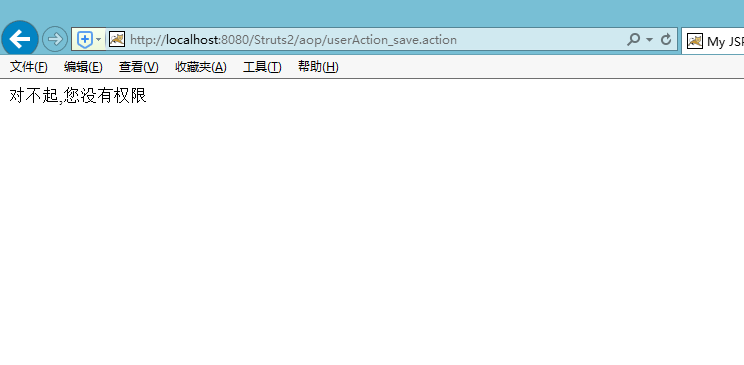
进入index.jsp进行登陆先
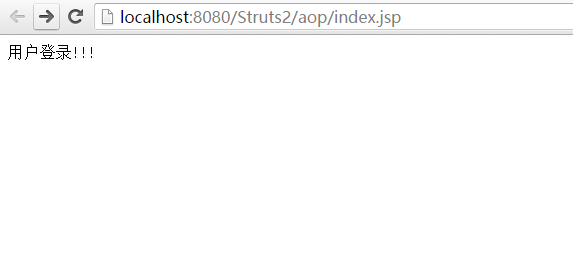
在进入test.jsp

点击超链接
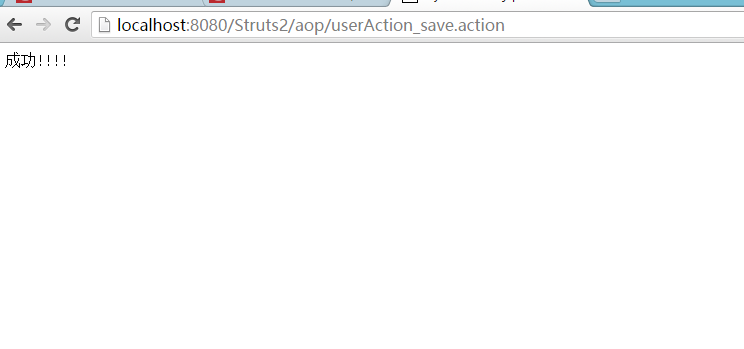
后台的输出:













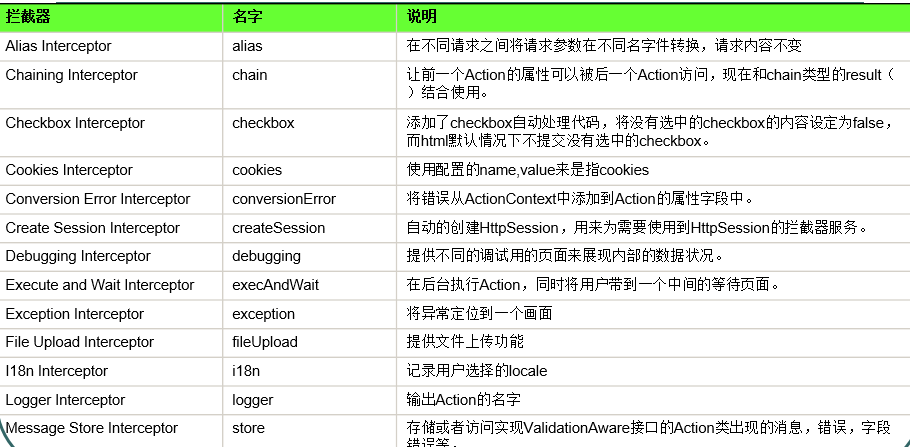
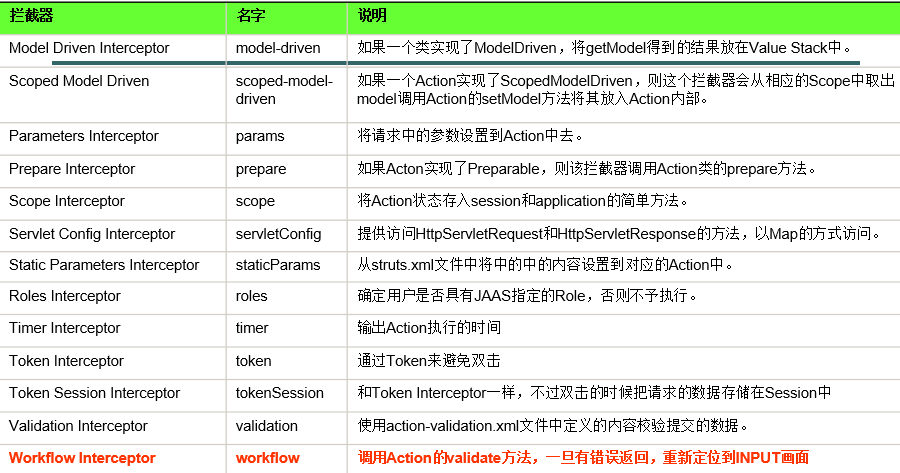














 657
657











 被折叠的 条评论
为什么被折叠?
被折叠的 条评论
为什么被折叠?








